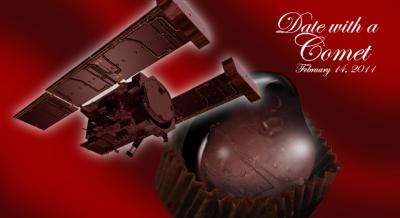Five things about NASA's Valentine's day comet

Here are five facts you should know about NASA's Stardust-NExT spacecraft as it prepares for a Valentine's "date" with comet Tempel 1. Feel free to sing along!
1. "The Way You Look Tonight" - The spacecraft is on a course to fly by comet Tempel 1 on Feb. 14 at about 8:37 p.m. PST (11:37 p.m. EST) -- Valentine's Day. Time of closest approach to Tempel 1 is significant because of the comet's rotation. We won't know until images are returned which face the comet has shown to the camera.
2. "It's All Coming Back To Me Now" - In 2004, Stardust became the first mission to collect particles directly from a comet, Wild 2, as well as samples of interstellar dust. The samples were returned in 2006 via a capsule that detached from the spacecraft and parachuted to the ground at a targeted area in Utah. Mission controllers then placed the still-viable Stardust spacecraft on a flight path that could reuse the flight system, if a target of opportunity presented itself. Tempel 1 became that target of opportunity.
3. "The First Time Ever I Saw Your Face" - The Stardust-NExT mission will allow scientists for the first time to look for changes on a comet's surface that occurred after one orbit around the sun. Tempel 1 was observed in 2005 by NASA's Deep Impact mission, which put an impactor on a collision course with the comet. Stardust-NExT might get a glimpse of the crater left behind, but if not, the comet would provide scientists with previously unseen areas for study. In addition, the Stardust-NExT encounter might reveal changes to Tempel 1 between Deep Impact and Stardust-Next, since the comet has completed an orbit around the sun.
4. "The Wind Beneath My Wings" - This Tempel 1 flyby will write the final chapter of the spacecraft's success story. The aging spacecraft approached 12 years of space travel on Feb. 7, logging almost 6 billion kilometers (3.5 billion miles) since launch. The spacecraft is nearly out of fuel. The Tempel 1 flyby and return of images are expected to consume the remaining fuel.
5. "Love is Now the Stardust of Yesterday" - Although the spacecraft itself will no longer be active after the flyby, the data collected by the Stardust-NExT mission will provide comet scientists with years of data to study how comets formed and evolved.
Bonus points for naming all the artists who sing these catchy tunes.
Provided by JPL/NASA





















